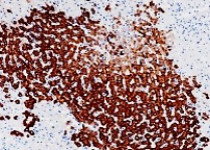ARG67036
anti-HBsAg antibody [SQab30330]
anti-HBsAg antibody [SQab30330] for IHC-Formalin-fixed paraffin-embedded sections and HBV
Overview
| Product Description | Recombinant rabbit Monoclonal antibody [SQab30330] recognizes HBSAg |
|---|---|
| Tested Reactivity | HBV |
| Tested Application | IHC-P |
| Host | Rabbit |
| Clonality | Monoclonal |
| Clone | SQab30330 |
| Isotype | IgG |
| Target Name | HBSAg |
| Antigen Species | Human |
| Immunogen | Recombinant protein of Human HBSAg. |
| Conjugation | Un-conjugated |
| Protein Full Name | Large envelope protein |
Application Instructions
| Application Suggestion |
|
||||
|---|---|---|---|---|---|
| Application Note | The dilutions indicate recommended starting dilutions and the optimal dilutions or concentrations should be determined by the scientist. | ||||
| Positive Control | HBV infected liver |
Properties
| Form | Liquid |
|---|---|
| Purification | Purification with Protein A. |
| Buffer | PBS, 0.01% Sodium azide, 40% Glycerol and 0.05%BSA. |
| Preservative | 0.01% Sodium azide |
| Stabilizer | 40% Glycerol and 0.05%BSA |
| Storage Instruction | For continuous use, store undiluted antibody at 2-8°C for up to a week. For long-term storage, aliquot and store at -20°C or below. Storage in frost free freezers is not recommended. Avoid repeated freeze/thaw cycles. Suggest spin the vial prior to opening. The antibody solution should be gently mixed before use. |
| Note | For laboratory research only, not for drug, diagnostic or other use. |
Bioinformation
| Gene Symbol | S |
|---|---|
| Gene Full Name | Large envelope protein |
| Background | Systematic vaccination of individuals at risk of exposure to the virus has been the main method of controlling the morbidity and mortality associated with hepatitis B. The first hepatitis B vaccine was manufactured by the purification and inactivation of HBsAg obtained from the plasma of chronic hepatitis B virus carriers. The vaccine is now produced by recombinant DNA techniques and expression of the S isoform in yeast cells. The pre-S region do not seem to induce strong enough antigenic response. |
| Function | The large envelope protein exists in two topological conformations, one which is termed 'external' or Le-HBsAg and the other 'internal' or Li-HBsAg. In its external conformation the protein attaches the virus to cell receptors and thereby initiating infection. This interaction determines the species specificity and liver tropism. This attachment induces virion internalization predominantly through caveolin-mediated endocytosis. The large envelope protein also assures fusion between virion membrane and endosomal membrane. In its internal conformation the protein plays a role in virion morphogenesis and mediates the contact with the nucleocapsid like a matrix protein. [UniProt] |
| Cellular Localization | Cytoplasm |
| Calculated MW | 42 kDa |
| PTM | Isoform M is N-terminally acetylated by host at a ratio of 90%, and N-glycosylated by host at the pre-S2 region. |
Images (1) Click the Picture to Zoom In






